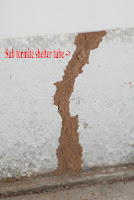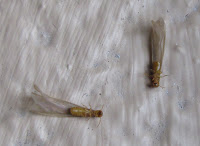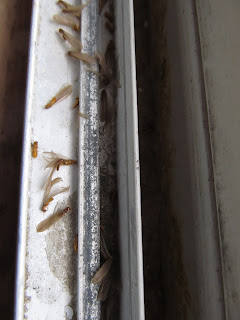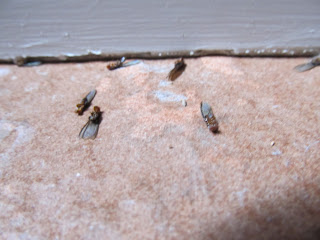Arizona termites…what’s eating at your home?
 |
| https://billstermiteco.com/termite-treatment-quote/ |
Arizona is home to at least 17 species of termites and despite
urban legend…not all Arizona termites will attack and/or destroy your home.
Subterranean termites, in general, are the most common type
found in the Phoenix area (below 4000 feet) and they tend to cause the most
damage.
Two species in particular…Reticulitermes (Eastern
Subterranean) and Heterotermes (native species) are most often found at homes
with active infestations and damage. “Desert
termites,” (Gnathamitermes and Wheeler termites) generate a lot of calls and
concern among homeowners and are seldom a threat to damage your home.
 Eastern Subterranean termites are found across the United
States and generate the bulk of the $2 billion dollars in termite damage every
year. These termites swarm in the spring
at night usually after a heavy rain.
Above 4000 feet they are the most common subterranean termite in
Arizona. Experienced termite inspectors
can quickly identify this termite by the larger, more flat termite tubes this
species constructs on stem walls or through large expansion joints.
Eastern Subterranean termites are found across the United
States and generate the bulk of the $2 billion dollars in termite damage every
year. These termites swarm in the spring
at night usually after a heavy rain.
Above 4000 feet they are the most common subterranean termite in
Arizona. Experienced termite inspectors
can quickly identify this termite by the larger, more flat termite tubes this
species constructs on stem walls or through large expansion joints. Our native species (Heterotermes) is the more common
subterranean termite found in the Sonoran Desert region. They adapt well to our dry conditions and
usually swarm during the monsoon season after heavy rains. Native termites migrate to areas and soil
with higher than average moisture and will often nest under concrete
slabs. This species is the smallest of
all termites found in Arizona and its small size gives it the ability to invade
a home through small stress cracks and expansion joints. Native termites is the only species in Arizona
that constructs “drop tubes,” often seen hanging from ceiling joists. Experienced termite inspectors will distinguish
this species by their smaller, rounder, stronger, and airtight shelter tubes.
Our native species (Heterotermes) is the more common
subterranean termite found in the Sonoran Desert region. They adapt well to our dry conditions and
usually swarm during the monsoon season after heavy rains. Native termites migrate to areas and soil
with higher than average moisture and will often nest under concrete
slabs. This species is the smallest of
all termites found in Arizona and its small size gives it the ability to invade
a home through small stress cracks and expansion joints. Native termites is the only species in Arizona
that constructs “drop tubes,” often seen hanging from ceiling joists. Experienced termite inspectors will distinguish
this species by their smaller, rounder, stronger, and airtight shelter tubes. Desert termites tend to generate the most calls and concerns
from Phoenix area homeowners. This
species swarms in the summer and is usually seen building tubes over dead
grass, or sheets of mud on wood fences.
Desert termites usually surface after rainfall or heavy watering when
our desert clay soil is “loosened.” It’s
not uncommon to see thin sheets of mud or tubes on Palm trees, Cactus or
covering wood debris left on the desert floor.
Desert termites seldom invade a home and rarely cause damage.
Desert termites tend to generate the most calls and concerns
from Phoenix area homeowners. This
species swarms in the summer and is usually seen building tubes over dead
grass, or sheets of mud on wood fences.
Desert termites usually surface after rainfall or heavy watering when
our desert clay soil is “loosened.” It’s
not uncommon to see thin sheets of mud or tubes on Palm trees, Cactus or
covering wood debris left on the desert floor.
Desert termites seldom invade a home and rarely cause damage.
Light Western Drywood termites are common is pockets of the
Valley and can be found throughout the Sonoran Desert below 4000 feet. Dark Western Drywood termites dominate the
region above 4000 feet. Western Drywood
termites usually swarm in July-August and can be destructive if not
detected. This species lives in the wood
it consumes and is rarely seen.
Experienced termite inspectors can determine the presence of this
species by the distinctive droppings and galleries.
If you have…or suspect If you have... or suspect Arizona termites…the first step is to
call an experience exterminator to determine if you have termites…and if those
termites are a threat to your home. Not
all termites in Arizona are equal.
Treatment methods can vary depending upon the invading species.
Call Arizona’s termite experts…Bills Pest and Termite for
your free inspection…or visit our website to schedule online.
Bills Pest Termite Control 602.308.4510





























